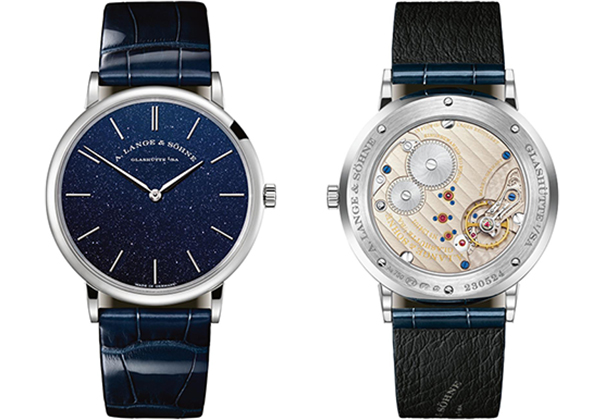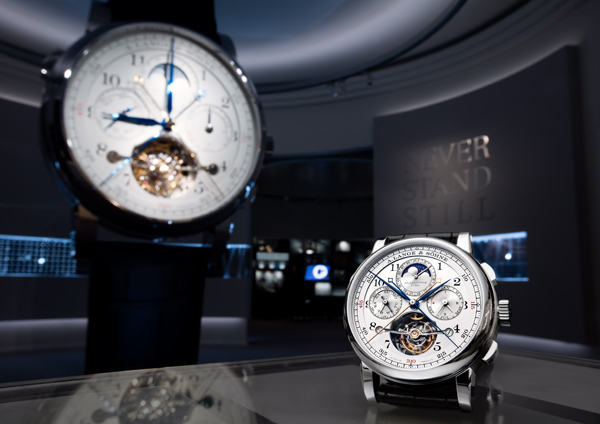In 1990, right after German reunification, the German automotive firm VDO purchased the title “A. Lange & Söhne” and established a brand new A. Lange & Söhne, based, like the first company, in Glashütte. Among the new firm’s first watches, the Lange 1, established in 1994, became Lange’s trademark style, exactly what the company describes as its “face.” The Lange 1, that looks the same as it did 20 years back, has a distinctive, asymmetrical dial using a big-date screen and “Auf/Ab” power-reserve index. (Before this year, the company replaced that caliber using a brand new one, additionally hand-wound.) The big-date screen, which can be patented, works by means of a “ones” ring bearing the digits 0 through 9 and a “tens” cross using the digits 1 through 3 and a blank area. A unique challenge for the engineers would be to make sure that the calendar switched correctly at the ends of months with 31 days. For all those months, the “ones” ring must remain motionless during the night prior to the first of the new month, while the “tens” cross legged through 90 levels to bring its clean segment into perspective. Lange & Söhne released its first self-winding watch, the Langematik, three years later it established the Lange 1. To increase the movement’s winding efficacy, the good gold strand in the Langematik is equipped with an outer platinum section. A reverser mechanism allows the rotor to communicate energy to the mainspring in both directions of rotation. An additional ruby posture supports the 2.5-gram ball-borne rotor.
The elegant personality of the latest Saxonia Thin version is based on the “less is more” principle. Its elegant white-gold case is merely 6.2 millimetres thick and has a diameter of 39 millimetres. The case colour is echoed by the two slender hour and minute hands as well as the twelve hour markers in rhodiumed gold. The hands and appliques contrast crisply against the background of the copper-blue dial. It is crafted from solid silver and coated with a thin layer of subtly shimmering goldstone. The precious facing requires an elaborate manufacture process that was originally developed in Venice in the 17th century. Microscopically small copper oxide crystals saturate the deep blue with choreographed reflections that are reminiscent of the stars in the blue midnight sky. A dark-blue hand-stitched alligator leather strap rounds out the expressiveness of the watch.

Saxonia Thin with a copper blue dial © A. Lange & Söhne
Watches at 40mm may be many things to a lot of people — too big for some, too small for many others, and yet only right for others. The precise proportions and the details can make a big difference. By way of example, Lange bezels are inclined to be on the other hand, along with the bezel this is no exception, which makes the watch wear a little big. However, the opinion neatly balances being both slim and sturdy, and it seems a commanding presence at the palm of your hand, with the ideal piece of heft, as anyone who has had the chance to deal with a Lange understands well.One of the nicest things about the case is the brushed ring round the sides. Not every manufacturer pays attention to details such as this, but Lange does, and it help places the German watchmaker’s creations apart from those of rivals. The combination of this polished, rounded bezel and the brushed instance ring adds depth and contrast to what would otherwise be a relatively traditional case.The lugs are slightly on the small side for a 40mm case. While this could easily ruin the balance of an otherwise wonderful watch, that’s not the case for the 1815 Annual Calendar. The shorter lugs really allow the situation to sense bigger on the wrist, which is a plus for people who may be afraid to choose the 40mm dip. But the best thing about this situation? The day/date corrector button located at two o’clock. With the 1815, you may just push the beautifully curved rectangular button in two o’clock and the day and date will progress simultaneously. Consider yourself #blessed without needing do deal with all the hassle that’s corrector pins.The 1815 Annual Calendar is manually-wound, with a power reserve of 72 hours. That means in the event that you let your watch go over three times between windings (state you leave it on your dresser over a long weekend, for instance), you will want to fix the date and day. Luckily, you can simply push the attractively curved rectangular button and the day and date will advance simultaneously.
Exactly what the watch was lost than a perpetual calendar, was a moon-phase screen and of course, a leap year indicator. Unlike a endless, the annual calendar does not account for a Leap Year, therefore it must be adjusted once per year in the end of February (in both Leap Years and non-Leap Years; since we mentioned, the yearly calendar just distinguishes between 30 and 31-day weeks).The automated caliber 315 S-QA was the first annual calendar motion and was made of 316 components. (Photo: Courtesy Christie’s)Now, if you’re a diehard calendar freak (bless you), then re-setting your watch at the conclusion of each February might appear dull, and if you therefore want to splurge to the mac-daddy endless calendar complication — fine. If you’re not, and you are okay with the excess work that is required to find your setting pin (that always seems to go lost) and push a button, then the yearly calendar is right for you — though with the Lange we’re about to enter, no more pin is necessary.The ref. 5035 stayed in production until 2005, once the mention 5146 was released as its own successor. The yearly calendar complication was, and remains, unique since it is more accessible price-wise (together with the knowledge that “accessible” is a relative term) while enabling individuals who wish to go into the world of intricate watches do this with dignity, and without needing to sell their home or shed a partner in the procedure. For Patek, the yearly calendar is a foundation product, also has been used in countless watches, from elegant limited editions to sporty chronographs in numerous guises.
Its puristic elegance is complemented by a manually wound movement finished to the highest standards of Saxon watchmaking artistry. The technical features of the manufacture calibre L093.1 – it is a scant 2.9 millimetres thick – include a flat mainspring barrel which delivers a maximum power reserve of 72 hours despite its compact size. The upper sides of the ratchet and crown wheels are solarised and visibly integrated into the three-quarter plate decorated with Glashütte ribbing. The escapement that adjoins the three-quarter plate is a special eye-catcher: A classic screw balance with a manufacture-made hairspring oscillates beneath the hand-engraved balance cock with the characteristic whiplash spring. The polished gold chatons, secured with blued screws, accentuate the character of this watch.


